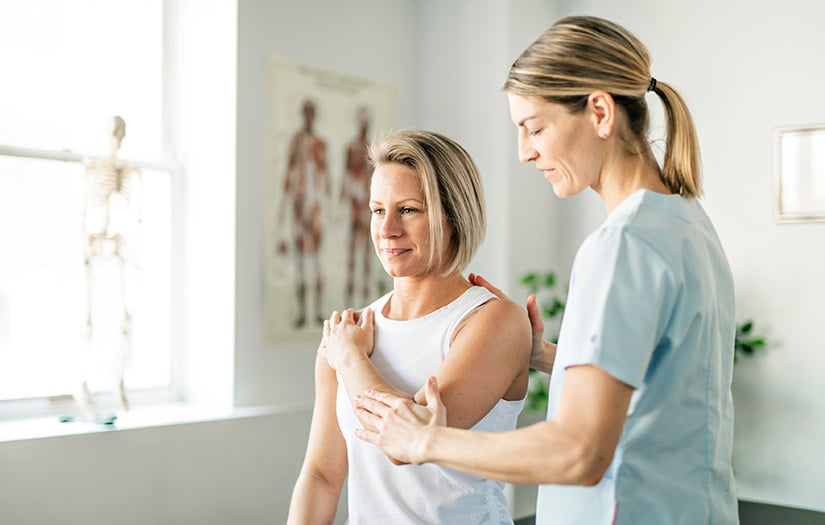In the first two parts of this three-part series, the benefits of measuring joint range of motion (ROM) and techniques used for measuring ROM of the lower extremities and the lumbopelvic-hip complex (LPHC) using a smartphone application were discussed.
This third and final part of this series will cover techniques used to measure ROM of the upper extremities at the shoulder (i.e., flexion, extension, internal rotation, and external rotation), elbow (i.e., elbow flexion), and wrist (i.e., flexion and extension) joints.
Just as a reminder, measuring ROM while performing the mobility tests provided in NASM’s updated Corrective Exercise Specialization (CES) certification course and Chapter 10 of the certification textbook resource Essentials of Corrective Exercise Training (2nd ed.) can confirm the fitness professional’s findings of both the static and dynamic postural assessments, as well as assist in determining possible muscular imbalances (i.e., overactive/shortened and underactive/lengthened muscles).
MEASURING UPPER EXTREMITY RANGE OF MOTION USING A SMARTPHONE APPLICATION
Note: Please provide instructions and demonstrate each test before testing the client.
Supine Passive Shoulder Flexion
Instructions for measuring ROM: Have the client lie supine on a table or the floor in a hook lying position (i.e., the hips flexed to approximately 45 degrees and the knees flexed to approximately 90 degrees, and the feet flat). With their palms facing each other, have the client flex their shoulders simultaneously by bringing their arms above their head as far as possible by relaxing and allowing gravity to pull their arms toward the table or floor.
The client’s lumbar spine should stay flat on the table or floor and not move into extension. In addition, the client’s elbows should be able to move into almost complete extension, while the scapulae should not elevate (National Academy of Sports Medicine, 2022). Set the smartphone application to 0 degrees while in the horizontal position and place the smartphone at the middle third of the posterior surface of the right upper arm on the triceps brachii muscle (Werner et al., 2014) (Figure 1).
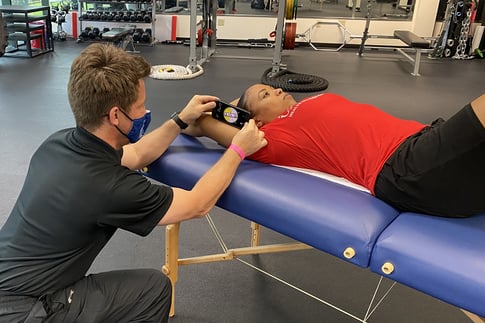
Figure 1. Supine Passive Shoulder Flexion
Please note, an additional fee may be required for the updated version of the Clinometer + Bubble Level smartphone application that reads beyond 90 degrees (i.e., 90 to 360 degrees). Measure to the nearest degree or tenth of a degree and repeat on the opposite shoulder.
Normal ROM: 150-180 degrees (American Medical Association, 1988; Greene & Heckman, 1994)
Overactive/shortened muscle/s if ROM is restricted: Latissimus dorsi, teres major, pectoralis major (lower fibers)
Supine Passive Shoulder Extension
Instructions for measuring ROM: Have the client lie supine on a table in a hook lying position and their body positioned to the far right side of the table. While keeping the elbow in extension, the wrist in a neutral position, and the palm facing upward (i.e., the radioulnar joint in supination), have the client allow gravity to pull their shoulder into extension, bringing the arm and hand down towards the floor while keeping the palm facing upward.
The client’s elbow should remain in extension, while the scapula should not elevate, tilt anteriorly, or protract, and the wrist should not extend (National Academy of Sports Medicine, 2022). Set the smartphone application to 0 degrees while in the horizontal position and place the smartphone at the middle third of the anterior surface of the right upper arm on the biceps brachii muscle (Werner et al. 2014) (Figure 2). Measure to the nearest degree or tenth of a degree and repeat on the opposite shoulder.
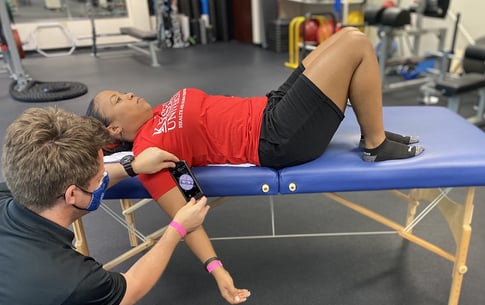
Figure 2. Supine Passive Shoulder Extension
Normal ROM: 50-60 degrees (American Medical Association, 1988; Greene & Heckman, 1994); 45 degrees (National Academy of Sports Medicine, 2022)
Overactive/shortened muscle/s if ROM is restricted: Anterior deltoid, pectoralis major (upper fibers), coracobrachialis, biceps brachii
Supine Passive Shoulder Internal Rotation
Instructions for measuring ROM: Have the client lie supine on a table or the floor in a hook lying position, with their right shoulder abducted to 90 degrees and their right elbow flexed to 90 degrees. While keeping the elbow in 90 degrees of flexion, the wrist in a neutral position, and the palm facing forward (i.e., the radioulnar joint in pronation), stabilize the client’s right scapula to prevent anterior tilting or anterior translation of the humeral head by placing your right palm on the client’s anterior shoulder and applying an appropriate amount of pressure downward.
While stabilizing the client’s scapula, hold the client’s right forearm with your left hand while guiding the client’s right shoulder anteriorly into internal rotation by allowing gravity to pull the client’s forearm towards the table or floor (Figure 3).

Figure 3. Stabilization of the scapula and anterior shoulder to prepare to measure supine passive shoulder internal rotation
The end range of motion is when the shoulder stops internally rotating. The fitness professional feels ROM restriction while guiding the client’s right shoulder into internal rotation with their left hand and stabilizing the client’s scapula with their right hand. Ask the client to please maintain the shoulder and arm at that position of internal rotation for testing.
The client’s elbow should remain in 90 degrees of flexion, while the scapula should not elevate, tilt anteriorly, or protract, and the wrist should not flex (National Academy of Sports Medicine, 2022). Set the smartphone application to 0 degrees while in the vertical position and place the smartphone at the middle third of the superior surface of the right forearm (Werner et al., 2014) (Figure 4). Measure to the nearest degree or tenth of a degree and repeat on the opposite shoulder.
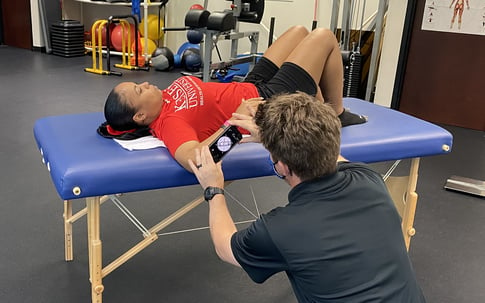
Figure 4. Supine Passive Shoulder Internal Rotation
Normal ROM: 45 degrees (Greene & Heckman, 1994)
Overactive/shortened muscle/s if ROM is restricted: Teres minor and infraspinatus
Supine Passive Shoulder External Rotation
Instructions for measuring ROM: Have the client lie supine on a table or the floor in a hook lying position, with their right shoulder abducted to 90 degrees and their right elbow flexed to 90 degrees. While keeping the elbow in 90 degrees of flexion, the wrist in a neutral position, and the palm facing forward (i.e., the radioulnar joint in pronation), have the client allow gravity to pull their shoulder posteriorly into external rotation, bringing their forearm towards the table or floor. The client’s elbow should remain in 90 degrees of flexion, while the scapula should not elevate, and the wrist should not extend (National Academy of Sports Medicine, 2022). Set the smartphone application to 0 degrees while in the vertical position and place the smartphone at the middle third of the superior surface of the right forearm (Werner et al. 2014) (Figure 5). Measure to the nearest degree or tenth of a degree and repeat on the opposite shoulder.

Figure 5. Supine Passive Shoulder External Rotation
Normal ROM: 90 degrees (American Medical Association, 1988; Greene & Heckman, 1994)
Overactive/shortened muscle/s if ROM is restricted: Subscapularis, teres major, latissimus dorsi, and pectoralis major
Active Elbow Flexion
Instructions for measuring ROM: While in a standing or seated position and the right arm straight at the client’s side, their elbow in full extension, and their palm facing forward (i.e., the radioulnar joint in supination), have the client flex their elbow as far as possible without flexing their wrist. Set the smartphone application to 0 degrees while in the vertical position and place the smartphone at the middle third of the anterior surface of the right forearm (Behnoush et al., 2016; Koong et al., 2020) (Figure 6).
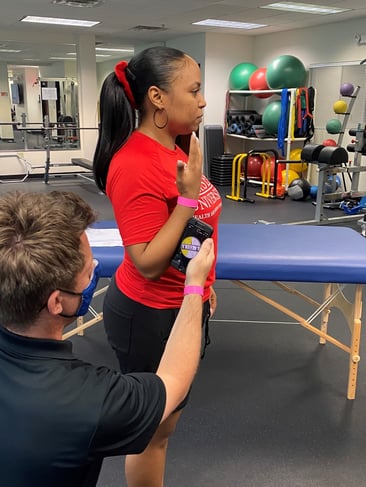
Figure 6. Active Elbow Flexion
Please note, an additional fee may be required for the updated version of the Clinometer + Bubble Level smartphone application that reads beyond 90 degrees (i.e., 90 to 360 degrees). Measure to the nearest degree or tenth of a degree and repeat on the opposite elbow.
Normal ROM: 140-150 degrees (American Medical Association, 1988; Greene & Heckman, 1994)
Overactive/shortened muscle/s if ROM is restricted: Triceps brachii
Active Wrist Flexion
Instructions for measuring ROM: While in a standing or seated position and the right upper arm straight at the client’s side, their elbow in 90 degrees of flexion, and their palm facing upward (i.e., the radioulnar joint in supination), have the client flex their wrist as far as possible without flexing their elbow. Set the smartphone application to 0 degrees while in the horizontal position and place the smartphone on the dorsal surface of the right hand with their fingers remaining straight (Modest et al., 2019) (Figure 7). Measure to the nearest degree or tenth of a degree and repeat on the opposite wrist.

Figure 7. Active Wrist Flexion
Normal ROM: 60-80 degrees (American Medical Association, 1988; Greene & Heckman, 1994)
Overactive/shortened muscle/s if ROM is restricted: Wrist extensors
Active Wrist Extension
Instructions for measuring ROM: While in a standing or seated position and the right upper arm straight at the client’s side, their elbow in 90 degrees of flexion, and their palm facing upward (i.e., the radioulnar joint in supination), have the client extend their wrist as far as possible without extending their elbow. Set the smartphone application to 0 degrees while in the horizontal position and place the smartphone on the palmar surface of the right hand with the fingers remaining straight (Modest et al., 2019) (Figure 8). Measure to the nearest degree or tenth of a degree and repeat on the opposite wrist.
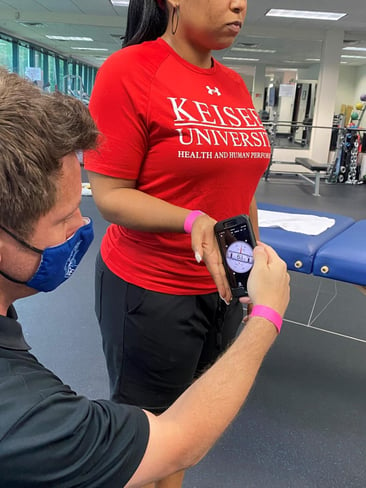
Figure 8. Active Wrist Extension
Normal ROM: 60-80 degrees (American Medical Association, 1988; Greene & Heckman, 1994)
Overactive/shortened muscle/s if ROM is restricted: Wrist flexors
MEASUREMENT OF RANGE OF MOTION AND THE FITNESS PROFESSIONAL: A TAKEAWAY
Over the last decade or so, more and more fitness professionals realize the benefits of performing a thorough health and fitness assessment with their clients. These health and fitness assessments now commonly include static and dynamic postural evaluations and mobility assessments to assist in detecting restricted joint ROM and possible muscular imbalances (i.e., overactive/shortened or underactive/lengthened muscles), which could lead to decreased performance and injury.
However, although mobility assessments, like those included in NASM’s updated Corrective Exercise Specialization (CES) certification course and Chapter 10 of the certification textbook resource Essentials of Corrective Exercise Training (2nd ed.), can assist in detecting limited joint ROM, simply assessing ROM through visual observation does not provide the fitness professional with objective data (i.e., degrees of ROM) which can be valuable information not only during the initial health and fitness assessment but more importantly during follow-up assessments to show progressive improvements in ROM within joints that may demonstrate limited mobility.
Therefore, the purpose of this three-part series was to instruct the fitness professional on how to measure joint ROM utilizing a smartphone application to collect objective data, and in turn, display to their clients the tangible benefits of a well-designed, individualized corrective exercise program.
Student in Figures: Darcel Tinner (Health & Human Performance major)
Student Photographer: Joshua Danson (Exercise Science major)
ROM Tester in Figures: Dr. Ryan R. Fairall
References:
- American Medical Association (1988). Guides to the evaluation of permanent impairment (3rd ed.). American Medical Association.
- Behnoush, B., Tavakoli, N., Bazmi, E., Fard, F. N., Shahi, M. H. P., Okazi, A., & Mokhtari, T. (2016). Smartphone and universal goniometer for measurement of elbow joint motions: A comparative study. Asian Journal of Sports Medicine, 7(2), 1–6. https://doi.org/10.5812/asjsm.30668
- Greene, W. B., & Heckman, J. D. (1994). The clinical measurement of joint motion. American Academy of Orthopedic Surgeons.
- Koong, D. P., Lee, J., Cheng, T. L., & Little, D. G. (2020). Validity and reliability of smartphone inclinometer applications for measurement of elbow range of motion in pediatric patients. Journal of Children’s Orthopaedics, 14(5), 488–494. https://doi.org/10.1302/1863-2548.14.200123
- Modest, J., Clair, B., DeMasi, R., Meulenaere, S., Howley, A., Aubin, M., & Jones, M. (2019). Self-measured wrist range of motion by wrist-injured and wrist-healthy study participants using a built-in iPhone feature as compared with a universal goniometer. Journal of Hand Therapy, 32(4), 507–514. https://doi.org/10.1016/j.jht.2018.03.004
- National Academy of Sports Medicine (2022). NASM essentials of corrective exercise training (2nd ed.). Jones & Bartlett Learning.
- Werner, B. C., Holzgrefe, R. E., Griffin, J. W., Lyons, M. L., Cosgrove, C. T., Hart, J. M., & Brockmeier, S. F. (2014). Validation of an innovative method of shoulder range-of-motion measurement using a smartphone clinometer application. Journal of Shoulder and Elbow Surgery, 23(11), 275–282. https://doi.org/10.1016/j.jse.2014.02.030

